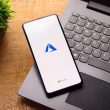Verizon survey: First responders ‘most dependent’ on smartphones—not LMR—on daily basis
Public safety currently depends slightly more on smartphones than land-mobile-radio (LMR) technology during a typical day, and this gap is expected to widen significantly in favor of smartphones and other broadband devices during the next five years, according to a national survey of first responders commissioned by Verizon Frontline.
More than 3,000 people who “self-selected” as a member of a police, fire or EMS agency—almost 50% of whom said they had been on the force at least 20 years—participated in the August survey conducted by Lexipol on behalf of Verizon that was released last week. Survey participants were asked a series of questions about existing and future public-safety technological capabilities, as well as their perceived readiness to respond to a crisis.
As many might expect, the survey indicates that communications reliability and interoperability are key needs for public safety. But the survey also indicated that LMR no longer is the most-used technology for first responders on a daily basis, as narrowband communications have been surpassed by smartphones powered by 4G and 5G networks.
When asked, “Of the devices you use on the job on a daily basis, which are you most dependent on?” 72% chose smartphones and 68% selected LMR (a Verizon spokesperson told IWCE’s Urgent Communications that survey participants were allowed to select multiple answers). Laptops were the choice of 52% of respondent and push-to-talk devices—a category differentiated from LMR and smartphones but not clearly defined—was chosen by 35%.
Those surveyed expect the dependence on broadband to increase significantly during the next five years.
When asked, “In five years, which of the following devices will you be most dependent on in your job?” smartphones again were the top choice, being selected by 74%–a similar figure to the current-day percentage. However, LMR was the selection of only 57%—an 11% decline compared to the present-day figure. The projected roles of laptops and push-to-talk devices in five years were almost unchanged from the current-day figures.
In contrast, public safety’s dependence on other broadband technologies is expected to increase dramatically during the next five years, as depicted in the following figures:
- Internet-connected vehicles, from 34% to 43%;
- Tablets, from 29% to 41%;
- Drones, from 5% to 16%; and
- Augmented reality (AR) and virtual reality (VR), from 1% to 4%.
In the survey, the greatest consensus was realized from a question that asked, “How important is coordination between public-safety agencies in responding to public-safety crises and emergency situations?” More than 93.4% of respondents described the matter as “critically important,” while another 5.67% described it as “somewhat important.
Similarly, 90% of respondents described interoperability between agencies to be “critical concern” (57%) or “somewhat of a concern” (33%).
When asked, “Which area do you think needs the most technological improvements, when it comes to public safety?” 32% replied network reliability, 24% chose interoperability, and 16% selected communications devices—a category that the survey describes as “LMR, PTT, tablets, etc.”
Another 12% of first responders surveyed identified the use of data for situational awareness—a category described as including “social-media signals, license-plate data, etc.” This category also was one of the few areas in the survey where there was a significant discrepancy in results between different types of public-safety users. While 14% of police respondents indicated that situational-awareness data is the area that needs the most technological improvement, only 8% of fire respondents and 8% of EMS respondents made the same choice.


















Go figure…a survey done by a cellular carrier shows that their devices are the one’s we depend on most. Who exactly did they survey? When I read the headline, I am thinking they talked to firefighters, police officers and medics in the field. We use and rely on and use our radios much more often than smartphones. Yes they are both needed, but per shift I would lean that most field personnel are using their radios more. Interesting in the survey results that LMR and Push-to-talk devices are listed separately… when you add them together, they significantly outnumber the smartphone line in the graph. All disciplines of public safety need to make our voices heard regarding our critical needs (hazard zone and mission critical communications) and not have solutions driven only by salesman and cellular engineers!